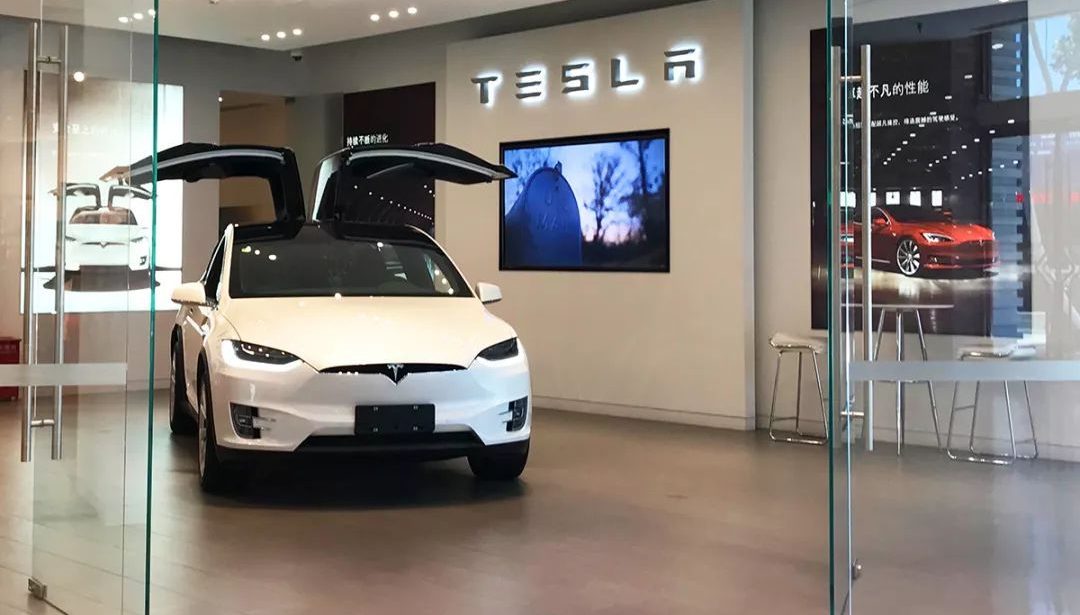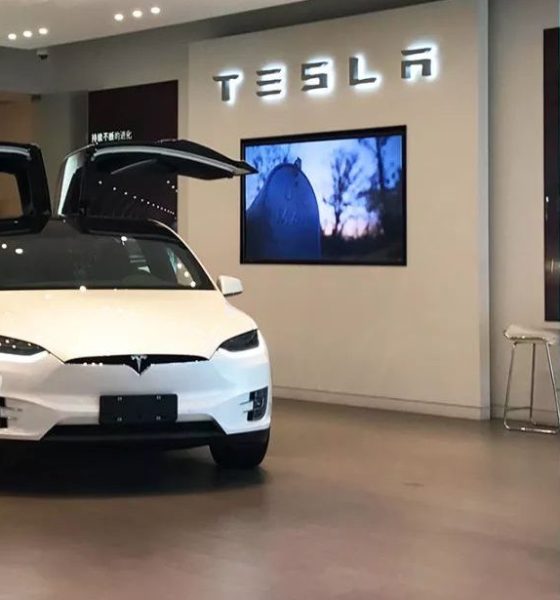

Investor's Corner
Tesla Gigafactory 3 funding reportedly incites competition among Chinese banks: insider
Tesla has an aggressive timetable for Gigafactory 3. During the facility’s groundbreaking event, Elon Musk mentioned that he is hoping for Model 3 production to begin before the end of 2019. That’s a very ambitious goal, even for a company as daring as Tesla. For the project to move on as scheduled, after all, Tesla would have to acquire enough funding for the massive facility — a feat widely considered challenging by the company’s critics.
Last year, reports emerged from local Chinese media hinting that Tesla was receiving assistance in receiving low-interest loans from local Shanghai banks to fund part of Gigafactory 3’s construction. If a recent report is any indication, though, it appears that the upcoming battery and electric car factory is attracting the interest of quite a few financial institutions willing to loan money for the project. An insider, who asked to remain anonymous, reportedly revealed to Chinese news agency NBD that several financial firms are actually competing to give loans to the carmaker.
“I heard that many banks are fighting for this. There are local banks in Shanghai, state-owned banks, and foreign banks,” the insider said, according to Hexun News.
The insider further noted that Tesla would be allowed to use its property rights and patents as collateral for the facility’s funding. Apart from this, the insiders also mentioned that under normal circumstances, it usually takes 4-6 months for companies to iron out details about the financing of large-scale projects. In the case of the Silicon Valley-based carmaker, though, the local government has reportedly set up a special team to endorse Tesla’s financing loans after just two months.
These recent reports all but highlight the Chinese government’s favor for Tesla and its support for Elon Musk’s vision. While Elon Musk and Tesla continue to incite an equal amount of admiration and criticism in the United States, after all, the company and its CEO appear to be widely respected in China. After the groundbreaking ceremony at the Gigafactory 3 site in Shanghai, for example, Elon Musk met with Chinese Premier Li Keqiang in Beijing’s Tower of Violet Light — a place usually reserved for foreign dignitaries, not automotive CEOs.
During their meeting, Li proved supportive of Musk’s plans for Tesla’s expansion in the country, as well as his ideas for Gigafactory 3’s automation. Even when Elon Musk described his vision of a factory that behaves like a “living being,” Li was not dismissive. At one point in their conversation, Li even suggested that China can just issue a “Chinese Green Card” to the Tesla CEO, so that Musk can explore his ideas freely.
Chinese media reported that many banks are now striving to make loans for Tesla Shanghai Gigafactory, including local banks in Shanghai, state-owned banks, and foreign banks. $TSLA #Tesla #China #GF3 #TeslaChina https://t.co/BXu3ydQzLx pic.twitter.com/GjjeRnQlSy
— vincent (@vincent13031925) January 11, 2019
Considering the treatment that Musk received in China during his visit, as well as the recent reports of banks competing to give funding for Gigafactory 3, it appears safe to state that Tesla is favored by the country’s government. And it’s not just Elon Musk’s treatment or support from financial institutions either. As revealed in previous reports, the government’s support for Tesla and Gigafactory 3 has been pretty evident for a while now.
Last year, the country all but changed its strict rules when it allowed Tesla to become the sole owner of the upcoming battery and electric car factory. The government’s hand also seemed evident when Tesla placed its bid for the 864,885-square meter plot of land in Shanghai’s Lingang Industrial Zone, as the electric car maker’s bid went completely unchallenged. Earlier this month, it was also revealed that the contractor for the construction of Gigafactory 3 is a subsidiary of China Construction, a firm owned by the government.
With such a notable level of support from the country’s officials and institutions, there is a very good chance that Gigafactory 3 would be completed well within Tesla’s projected timetable. What remains to be seen, though, is if the electric car maker can set up its production lines in Shanghai at the same pace. With things now in motion, the ball now appears to be in Tesla’s court.

Investor's Corner
Tesla stock closes at all-time high on heels of Robotaxi progress

Tesla stock (NASDAQ: TSLA) closed at an all-time high on Tuesday, jumping over 3 percent during the day and finishing at $489.88.
The price beats the previous record close, which was $479.86.
Shares have had a crazy year, dipping more than 40 percent from the start of the year. The stock then started to recover once again around late April, when its price started to climb back up from the low $200 level.
This week, Tesla started to climb toward its highest levels ever, as it was revealed on Sunday that the company was testing driverless Robotaxis in Austin. The spike in value pushed the company’s valuation to $1.63 trillion.
Tesla Robotaxi goes driverless as Musk confirms Safety Monitor removal testing
It is the seventh-most valuable company on the market currently, trailing Nvidia, Apple, Alphabet (Google), Microsoft, Amazon, and Meta.
Shares closed up $14.57 today, up over 3 percent.
The stock has gone through a lot this year, as previously mentioned. Shares tumbled in Q1 due to CEO Elon Musk’s involvement with the Department of Government Efficiency (DOGE), which pulled his attention away from his companies and left a major overhang on their valuations.
However, things started to rebound halfway through the year, and as the government started to phase out the $7,500 tax credit, demand spiked as consumers tried to take advantage of it.
Q3 deliveries were the highest in company history, and Tesla responded to the loss of the tax credit with the launch of the Model 3 and Model Y Standard.
Additionally, analysts have announced high expectations this week for the company on Wall Street as Robotaxi continues to be the focus. With autonomy within Tesla’s sights, things are moving in the direction of Robotaxi being a major catalyst for growth on the Street in the coming year.
Elon Musk
Tesla needs to come through on this one Robotaxi metric, analyst says
“We think the key focus from here will be how fast Tesla can scale driverless operations (including if Tesla’s approach to software/hardware allows it to scale significantly faster than competitors, as the company has argued), and on profitability.”

Tesla needs to come through on this one Robotaxi metric, Mark Delaney of Goldman Sachs says.
Tesla is in the process of rolling out its Robotaxi platform to areas outside of Austin and the California Bay Area. It has plans to launch in five additional cities, including Houston, Dallas, Miami, Las Vegas, and Phoenix.
However, the company’s expansion is not what the focus needs to be, according to Delaney. It’s the speed of deployment.
The analyst said:
“We think the key focus from here will be how fast Tesla can scale driverless operations (including if Tesla’s approach to software/hardware allows it to scale significantly faster than competitors, as the company has argued), and on profitability.”
Profitability will come as the Robotaxi fleet expands. Making that money will be dependent on when Tesla can initiate rides in more areas, giving more customers access to the program.
There are some additional things that the company needs to make happen ahead of the major Robotaxi expansion, one of those things is launching driverless rides in Austin, the first city in which it launched the program.
This week, Tesla started testing driverless Robotaxi rides in Austin, as two different Model Y units were spotted with no occupants, a huge step in the company’s plans for the ride-sharing platform.
Tesla Robotaxi goes driverless as Musk confirms Safety Monitor removal testing
CEO Elon Musk has been hoping to remove Safety Monitors from Robotaxis in Austin for several months, first mentioning the plan to have them out by the end of 2025 in September. He confirmed on Sunday that Tesla had officially removed vehicle occupants and started testing truly unsupervised rides.
Although Safety Monitors in Austin have been sitting in the passenger’s seat, they have still had the ability to override things in case of an emergency. After all, the ultimate goal was safety and avoiding any accidents or injuries.
Goldman Sachs reiterated its ‘Neutral’ rating and its $400 price target. Delaney said, “Tesla is making progress with its autonomous technology,” and recent developments make it evident that this is true.
Investor's Corner
Tesla gets bold Robotaxi prediction from Wall Street firm
Last week, Andrew Percoco took over Tesla analysis for Morgan Stanley from Adam Jonas, who covered the stock for years. Percoco seems to be less optimistic and bullish on Tesla shares, while still being fair and balanced in his analysis.

Tesla (NASDAQ: TSLA) received a bold Robotaxi prediction from Morgan Stanley, which anticipates a dramatic increase in the size of the company’s autonomous ride-hailing suite in the coming years.
Last week, Andrew Percoco took over Tesla analysis for Morgan Stanley from Adam Jonas, who covered the stock for years. Percoco seems to be less optimistic and bullish on Tesla shares, while still being fair and balanced in his analysis.
Percoco dug into the Robotaxi fleet and its expansion in the coming years in his latest note, released on Tuesday. The firm expects Tesla to increase the Robotaxi fleet size to 1,000 vehicles in 2026. However, that’s small-scale compared to what they expect from Tesla in a decade.
Tesla expands Robotaxi app access once again, this time on a global scale
By 2035, Morgan Stanley believes there will be one million Robotaxis on the road across multiple cities, a major jump and a considerable fleet size. We assume this means the fleet of vehicles Tesla will operate internally, and not including passenger-owned vehicles that could be added through software updates.
He also listed three specific catalysts that investors should pay attention to, as these will represent the company being on track to achieve its Robotaxi dreams:
- Opening Robotaxi to the public without a Safety Monitor. Timing is unclear, but it appears that Tesla is getting closer by the day.
- Improvement in safety metrics without the Safety Monitor. Tesla’s ability to improve its safety metrics as it scales miles driven without the Safety Monitor is imperative as it looks to scale in new states and cities in 2026.
- Cybercab start of production, targeted for April 2026. Tesla’s Cybercab is a purpose-built vehicle (no steering wheel or pedals, only two seats) that is expected to be produced through its state-of-the-art unboxed manufacturing process, offering further cost reductions and thus accelerating adoption over time.
Robotaxi stands to be one of Tesla’s most significant revenue contributors, especially as the company plans to continue expanding its ride-hailing service across the world in the coming years.
Its current deployment strategy is controlled and conservative to avoid any drastic and potentially program-ruining incidents.
So far, the program, which is active in Austin and the California Bay Area, has been widely successful.








